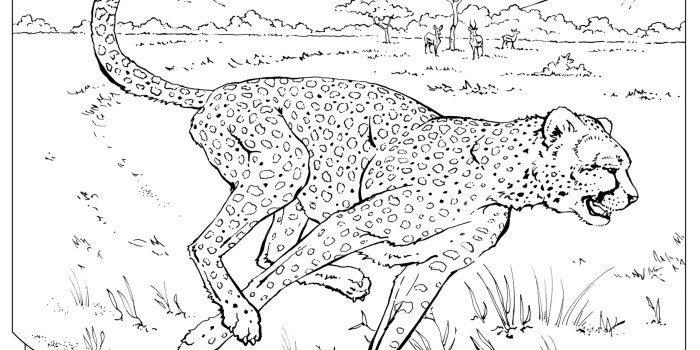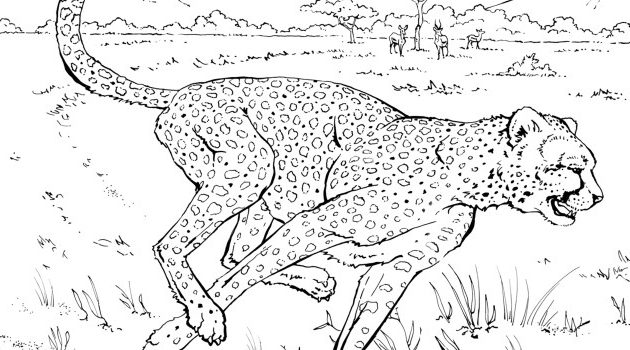Animal Selection and Representation

Realistic zoo animal coloring pages – Creating realistic coloring pages of zoo animals requires careful consideration of both visual appeal and the challenges inherent in representing animal features accurately. The chosen animals should be engaging for the target audience while also offering opportunities to depict a range of textures and details. A successful design balances complexity with accessibility, ensuring the coloring experience is both rewarding and achievable.
Selecting animals that are both visually appealing and familiar to children is crucial for the success of a coloring page project. High contrast markings and interesting textures translate well into a coloring format, making the task more engaging. Similarly, familiarity ensures children will connect with the animal and be more motivated to color it.
Suitable Zoo Animals for Realistic Coloring Pages
The following five zoo animals offer a diverse range of textures and visual characteristics, making them ideal subjects for realistic coloring pages:
- Lion: The lion’s majestic mane, contrasting with its muscular body, provides a compelling subject with a variety of textures to color.
- Tiger: The tiger’s striking orange and black stripes, along with its textured fur, offer a visually stimulating and relatively straightforward coloring experience.
- Giraffe: The giraffe’s unique spotted pattern and long neck provide a distinctive silhouette and opportunity for detailed work on the spots and fur.
- Elephant: The elephant’s wrinkled skin and large ears offer a fascinating challenge in texture representation, allowing for shading and detail work.
- Peacock: The peacock’s vibrant plumage presents a complex but rewarding coloring challenge, allowing for the depiction of intricate feather details and iridescent colors.
Challenges in Representing Animal Textures, Realistic zoo animal coloring pages
Accurately representing the texture and detail of animal fur, scales, or feathers in a coloring page format presents several significant challenges. The two-dimensional nature of the page limits the ability to convey three-dimensional depth and texture. Furthermore, the need for simplification to make the coloring page accessible to a wide range of ages requires careful consideration of detail levels.
For example, the fine details of a lion’s mane, the individual scales of a reptile, or the intricate patterns on a bird’s feathers can be difficult to represent effectively within the constraints of a coloring page. Too much detail can overwhelm the colorist, while too little detail can result in a less engaging image. Finding the right balance is crucial.
Simplifying Animal Features for Coloring Pages
The process of simplifying complex animal features while maintaining realism involves careful observation and selective detail. The goal is to retain the essential characteristics of the animal while removing unnecessary complexity. This is often achieved by focusing on key shapes and patterns, and suggesting texture rather than explicitly rendering every detail.
Realistic zoo animal coloring pages offer a wonderful opportunity to learn about animal anatomy and detail. If you’re looking for a fun extension to your collection, consider supplementing them with some vibrant jungle creatures! You can find a fantastic selection of free printable jungle animal coloring pages to add even more variety to your coloring experience, then return to your realistic zoo animals for a detailed comparison.
| Detailed Animal Feature (Lion Mane) | Simplified Animal Feature (Lion Mane) |
|---|---|
| Individual hairs, varying lengths and curliness, subtle shading to show depth and volume, highlights and shadows to create realism. A highly detailed and complex representation, potentially overwhelming for coloring. | Simplified strands of hair grouped together, indicated by darker and lighter areas to suggest volume and texture. Key areas of the mane highlighted to guide coloring. A more manageable representation focusing on overall shape and texture. |
Educational Value and Added Features

Enhancing realistic zoo animal coloring pages with educational elements transforms a simple activity into a valuable learning experience. By incorporating factual information and engaging activities, children can develop their knowledge of animals, their habitats, and the importance of conservation. This approach fosters creativity while simultaneously promoting educational growth.
Adding educational components can significantly increase the engagement and learning potential of the coloring pages. Integrating factual information directly onto the page, or providing accompanying materials, allows children to learn while they color. The integration of creative activities further encourages active participation and deeper understanding.
Habitat Drawing Section Design
A coloring page featuring a realistic depiction of a snow leopard could include a smaller section dedicated to habitat representation. This section would be located at the bottom of the page, separated by a subtle line. The main section would showcase a detailed snow leopard, ready for coloring. The smaller section, roughly one-third the size of the main image, would be titled “Snow Leopard’s Home.” Within this section, children could draw elements of the snow leopard’s natural habitat, such as rocky mountains, sparse vegetation, and perhaps even other animals they might find in the same ecosystem (like a Himalayan blue poppy or a pika).
The space provided would encourage children to use their imagination while reinforcing their understanding of the animal’s environment. Simple prompts such as “Draw the plants the snow leopard eats,” or “What kind of weather does the snow leopard live in?” could further guide their creativity. The use of light gray pencil lines to indicate mountain ranges and other features would offer a starting point without limiting artistic expression.
The inclusion of supplementary activities expands the educational value beyond the coloring page itself. These activities can reinforce learning and provide different avenues for engagement.
- Create an Animal Fact File: Children research and record interesting facts about the colored animal, including its diet, lifespan, and conservation status. This encourages research skills and information organization.
- Design a Zoo Enclosure: Children design a zoo enclosure suitable for the animal, considering its habitat needs and enrichment opportunities. This promotes problem-solving and critical thinking.
- Write a Story: Children create a short story featuring the animal as the main character, incorporating details about its habitat and behavior. This encourages creative writing and imaginative storytelling.
- Animal Habitat Diorama: Children construct a miniature diorama representing the animal’s habitat, using recyclable materials. This fosters creativity and understanding of spatial relationships.
- Compare and Contrast: Children compare and contrast the colored animal with another animal from a similar habitat or with similar characteristics, identifying similarities and differences. This enhances observational and analytical skills.
Presentation and Distribution: Realistic Zoo Animal Coloring Pages
Reaching the target audience effectively requires a multi-pronged approach to distribution and marketing, leveraging both digital and physical channels to maximize reach and sales. A well-defined strategy will ensure the coloring pages are accessible to parents, educators, and children themselves.Different formats offer distinct advantages in reaching various segments of the target market. Offering diverse options allows for flexibility and caters to different preferences and purchasing habits.
Distribution Formats
Printable PDF files offer immediate accessibility and convenience. Customers can download and print the coloring pages at their convenience, making it an ideal option for those seeking instant gratification or wanting to control print quality and quantity. Physical books, on the other hand, provide a tangible product with a higher perceived value. This format is particularly appealing to those who appreciate the feel of physical books or prefer a curated collection of designs.
Online platforms, such as Etsy, Amazon, or dedicated websites, allow for global reach and 24/7 accessibility. These platforms offer built-in marketing tools and a large customer base, significantly expanding the potential audience.
Marketing and Promotion Plan
A successful marketing strategy necessitates a clear understanding of the target audience and their preferences. The following strategies will effectively promote the realistic zoo animal coloring pages.
- Social Media Marketing: Utilizing platforms like Instagram, Pinterest, and Facebook to showcase high-quality images of the coloring pages, engage with potential customers, and run targeted advertising campaigns. Visual content, such as short videos of children coloring the pages or time-lapses of the coloring process, would be highly engaging.
- Search Engine Optimization (): Optimizing the product listings and website content with relevant s (e.g., “realistic animal coloring pages,” “zoo animal coloring book,” “printable coloring pages for kids”) to improve search engine ranking and organic visibility.
- Collaborations with Influencers: Partnering with parenting bloggers, educators, or craft enthusiasts to review and promote the coloring pages to their followers. This leverages their established audience and credibility.
- Paid Advertising: Running targeted advertising campaigns on social media and search engines to reach specific demographics interested in coloring books, educational materials, or zoo animals. A/B testing different ad creatives will help optimize campaign performance.
- Email Marketing: Building an email list to share updates, promotions, and new product releases with subscribers. This allows for direct communication and fosters customer loyalty.
Visually Appealing Product Descriptions and Images
High-quality images are crucial for attracting attention and conveying the product’s value. Images should showcase the realistic detail and vibrancy of the animal illustrations. Multiple images showing different pages from the coloring book would be beneficial. For example, one image could feature a close-up of a detailed lion’s mane, another a playful monkey, and a third a majestic elephant.Example Product Description:”Unleash your child’s creativity with our stunning collection of Realistic Zoo Animal Coloring Pages! Featuring 20 meticulously detailed illustrations of majestic lions, playful monkeys, graceful giraffes, and many more fascinating creatures, this coloring book offers an engaging and educational experience.
Each page is printed on high-quality, thick paper to prevent bleed-through, ensuring a smooth and enjoyable coloring experience. Perfect for children aged 4 and up, these coloring pages promote fine motor skills, color recognition, and creativity. Download your instant PDF today or order your physical copy for a truly captivating coloring adventure!”

